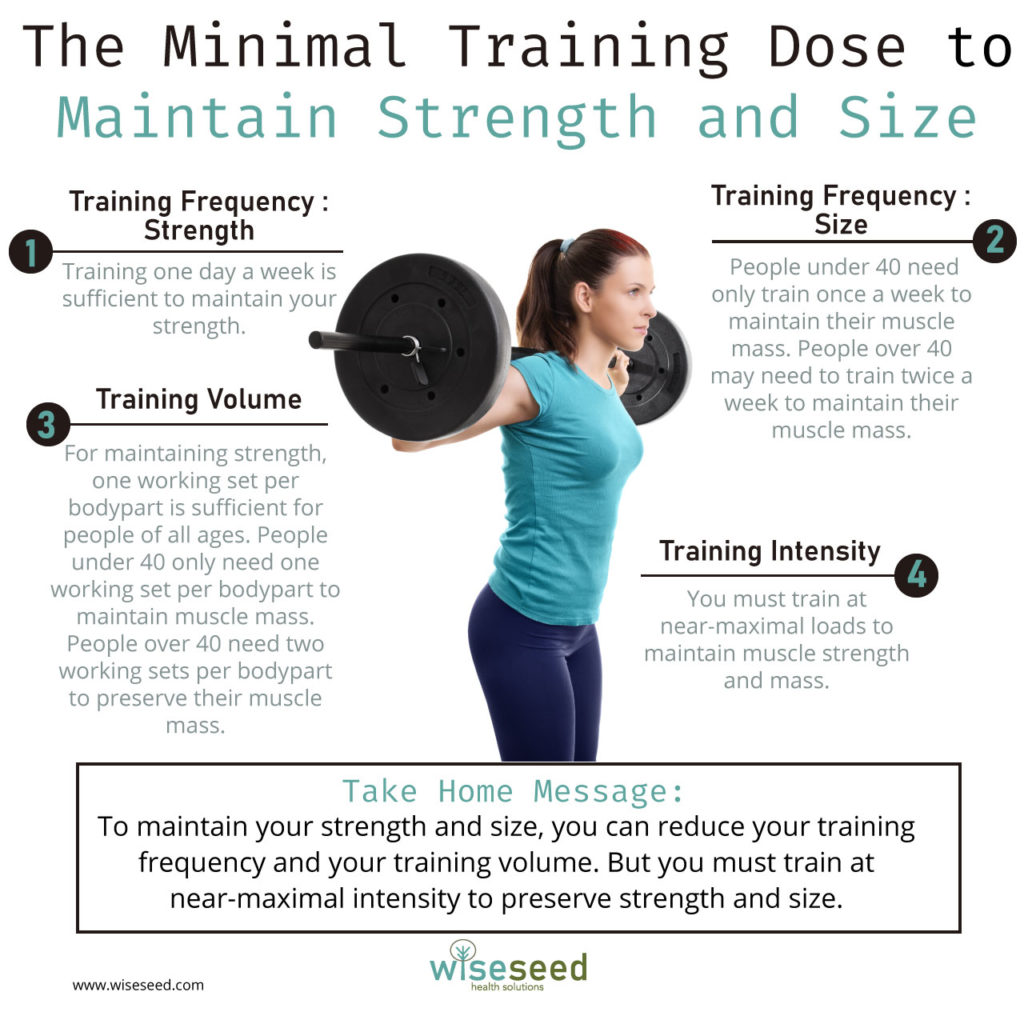The Minimal Training Dose for Strength and Size

Use it or lose it.
Resilient people adapt, overcome and keep moving forward despite adversity. To do this, you need to have an emergency strategy in place and ready to deploy. This way, when the proverbial hits the fan, you can quickly refocus your efforts on the immediate threat, safe in the knowledge that are still on the path to achieving your life goals.
In the preceding article, I outlined the minimal exercise dose required to preserve your aerobic fitness and endurance. In this article, I focus on the minimum training dose required for maintaining your strength and muscle mass. This information is based on the superb review recently published by Dr Barry Spiering and Colleagues 1.
The key variables.
There are three key variables that you need to consider when designing your ‘minimum dose’ workout plan. The first is frequency, which simply refers to the number of workouts you perform each week. Next is volume, which in this context refers to the number of sets performed per body-part. Finally, there is intensity, which is the load lifted relative to your maximum effort. In this article, intensity refers to the maximal load that can be lifted for a set number of repetitions. For example, the heaviest weight you can lift for 10 repetitions is your 10-rep max (10RM).
Reducing Frequency.
If your goal is to maintain your maximal strength, you can safely reduce your strength training frequency down to 1 day per week. However, you must maintain your volume and intensity for this to work 1. For example, soccer players who reduced their strength training down to 1 day per week maintained both their maximum squatting strength and their top sprinting speed 1.
The story is slightly more complicated for those of you wishing to maintain your muscle mass. If you are young (less than 35 years old) then you are in luck. One session per week is sufficient to maintain your muscle mass 1. Sadly, if you are older than 60, you should train at least twice per week to maintain your muscle size 1.
Unfortunately, the Author’s make no recommendation for those of us who are between 35 and 65 years old. My suggestion is that people under 40 can probably get away with training one day a week. However, those of us who are over-40 may need to hit the gym twice a week to maintain our muscle mass.
Reducing volume and frequency.
To date, no studies have been published that explore the minimal volume required to maintain strength or muscle mass. However, several studies have looked at the combined effect of reducing volume and frequency. Synthesizing these studies, Spiering and Colleagues make the following recommendations 1.
If your only goal is to preserve your strength, then a single working set performed one day per week is sufficient to maintain your strength 1. Importantly, this holds true for lifters both young and old. The recommendations for maintaining muscle size depends on your age. Younger lifters can get away with one working set per body part, one day a week.
Sadly, us older folk need to put in a bit more work to maintain our muscle mass. Specifically, if you are an older lifter like me, you will need to train twice a week using 2-3 sets per body part to maintain your muscle mass 1.
Reducing intensity.
If you want to maintain strength and muscle mass using a reduced training frequency and/or volume, then you are going to have to train at near maximal intensity 1. In other words, if you want to maintain your strength and size, then you have to train hard.
Putting it all together.
The minimal exercise dose to maintain strength (for all ages) and size (for people under 35) is to train one day per week, using one working set per body part. To maintain size, older individuals need to train more often (twice a week) using 2-3 working sets per body part.
Your optimal exercise choice consists of heavy compound movements. For example, your upper body pushing exercises could include bench press, shoulder press or dips. Your upper body pulling exercises should include pull-ups and rows. For your lower body pushing exercises, focus on some form of squatting or leg press. Finally, for your lower body pulling exercises, make sure you include some hinge-based movements such as deadlifts or power cleans.
Obviously, you should base your exercise selection on your mobility, injuries and your technique. Because you will be training at high intensity, you should only select exercises that you can perform safely under heavy load.
As for rep range, 6-12 reps should do the trick. Stick to around 6-8 if you are focused on strength, and 10-12 reps if you are more focused in size. Just remember, your working sets must be performed at near-maximal intensity for you to maintain your strength and size.
And don’t forget that you still have to warm up! You should always do a general warm-up at the start of your work-out, and then gradually work up to your working set for each lift.
Take Home Message.
Both your strength and your endurance will noticeably decline within as little as two weeks if you completely stop training. Therefore, it’s important that you keep training through life’s disruptions.
The good news is that it’s relatively easy to maintain your strength and fitness levels. For most people, one hard strength training session per week, combined with one hard conditioning session per week (preferably performed on non-consecutive days), is sufficient to maintain your strength and fitness for extended periods of time.
Please click on the link below to download your free PDF.

References and Further Reading
1 Spiering, B. A., Mujika, I., Sharp, M. A. & Foulis, S. A. Maintaining Physical Performance: The Minimal Dose of Exercise Needed to Preserve Endurance and Strength Over Time. J Strength Cond Res, doi:10.1519/jsc.0000000000003964 (2021).
Acknowledgements
Images by Andrey Burmakin and Mendelex
Disclaimer
The material displayed on this website is provided without any guarantees, conditions or warranties as to its accuracy.
Information written and expressed on this website is for education purposes and interest only. It is not intended to replace advice from your medical or healthcare professional.
You are encouraged to make your own health care choices based on your own research and in conjunction with your qualified practitioner.
The information provided on this website is not intended to provide a diagnosis, treatment or cure for any diseases. You should seek medical attention before undertaking any diet, exercise, other health program or other procedure described on this website.
To the fullest extent permitted by law we hereby expressly exclude all warranties and other terms which might otherwise be implied by statute, common law or the law of equity and must not be liable for any damages whatsoever, including but without limitation to any direct, indirect, special, consequential, punitive or incidental damages, or damages for loss of use, profits, data or other intangibles, damage to goodwill or reputation, injury or death, or the cost of procurement of substitute goods and services, arising out of or related to the use, inability to use, performance or failures of this website or any linked sites and any materials or information posted on those sites, irrespective of whether such damages were foreseeable or arise in contract, tort, equity, restitution, by statute, at common law or otherwise.

Ten Minutes is All You Need
Research has shown that ten minutes of moderate-to-vigorous exercise performed each day is enough to significantly reduce your risk of early death.

How to Find Significance in Life: Thriving in Solitude Part Three
Meaning in life research provides several behaviors and beliefs that can help you find significance in life.




